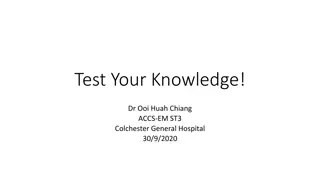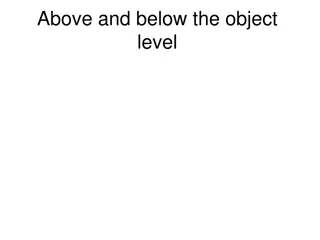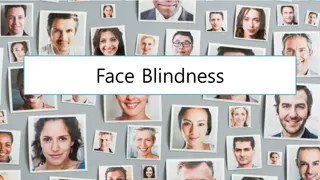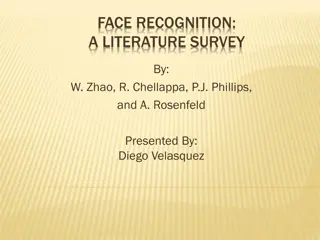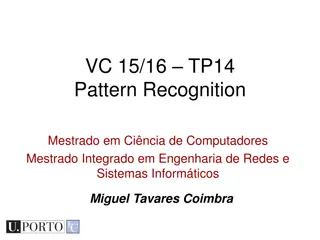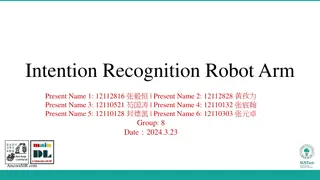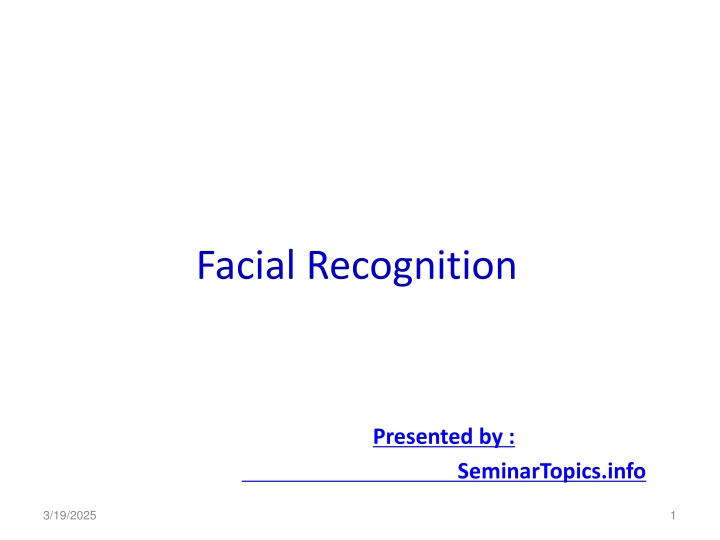
Facial Recognition
Learn about facial recognition technology, its history, implementation, strengths, weaknesses, and applications. Explore how biometrics play a crucial role in user identification and authentication, making transactions more secure and efficient in the digital era.
Download Presentation

Please find below an Image/Link to download the presentation.
The content on the website is provided AS IS for your information and personal use only. It may not be sold, licensed, or shared on other websites without obtaining consent from the author. If you encounter any issues during the download, it is possible that the publisher has removed the file from their server.
You are allowed to download the files provided on this website for personal or commercial use, subject to the condition that they are used lawfully. All files are the property of their respective owners.
The content on the website is provided AS IS for your information and personal use only. It may not be sold, licensed, or shared on other websites without obtaining consent from the author.
E N D
Presentation Transcript
Facial Recognition Presented by : SeminarTopics.info 3/19/2025 1
Outline 1. Introduction 2. Biometrics 3. History 4. Facial Recognition 5. Implementation 6. How it works 7. Strengths & Weaknesses 8. Applications 9. Conclusion 10. Refrences 3/19/2025 2
Introduction Everyday actions are increasingly being handled electronically, instead of pencil and paper or face to face. This growth in electronic transactions results in great demand for fast and accurate user identification and authentication. 3/19/2025 3
Access codes for buildings, banks accounts and computer systems often use PIN's for identification and security clearences. Using the proper PIN gains access, but the user of the PIN is not verified. When credit and ATM cards are lost or stolen, an unauthorized user can often come up with the correct personal codes. Face recognition technology may solve this problem since a face is undeniably connected to its owner expect in the case of identical twins. 3/19/2025 4
Biometrics A biometric is a unique, measurable characteristic of a human being that can be used to automatically recognize an individual or verify an individual s identity. Biometrics can measure both physiological and behavioral characteristics. Physiological biometrics:- This biometrics is based on measurements and data derived from direct measurement of a part of the human body. Behavioral biometrics:- this biometrics is based on measurements and data derived from an action. 3/19/2025 5
Types Of Biometrics PHYSIOLOGICAL BEHAVIORAL a. Finger-scan b. Facial Recognition c. Iris-scan d. Retina-scan e. Hand-scan a. Voice-scan b. Signature-scan c. Keystroke-scan 3/19/2025 6
Facial Recognition ??? It requires no physical interaction on behalf of the user. It is accurate and allows for high enrolment and verification rates. It can use your infrastructure, existing camaras and image capture Devices will work with no problems existing hardware 3/19/2025 7
History In 1960s, the first semi-automated system for facial recognition to locate the features(such as eyes, ears, nose and mouth) on the photographs. In 1970s, Goldstein and Harmon used 21 specific subjective markers such as hair color and lip thickness to automate the recognition. In 1988, Kirby and Sirovich used standard linear algebra technique, to the face recognition. 3/19/2025 8
Facial Recognition In Facial recognition there are two types of comparisons:- VERIFICATION- The system compares the given individual with who they say they are and gives a yes or no decision. IDENTIFICATION- The system compares the given individual to all the Other individuals in the database and gives a ranked list of matches. 3/19/2025 9
Contd All identification or authentication technologies operate using the following four stages: Capture: A physical or behavioural sample is captured by the system during Enrollment and also in identification or verification process. Extraction: unique data is extracted from the sample and a template is created. Comparison: the template is then compared with a new sample. Match/non-match: the system decides if the features extracted from the new Samples are a match or a non match. 3/19/2025 10
Implementation The implementation of face recognition technology includes the following four stages: Image acquisition Image processing Distinctive characteristic location Template creation Template matching 3/19/2025 11
Image acquisition Facial-scan technology can acquire faces from almost any static camera or video system that generates images of sufficient quality and resolution. High-quality enrollment is essential to eventual verification and identification enrollment images define the facial characteristics to be used in all future authentication events. 3/19/2025 12
3/19/2025 13
Image Processing Images are cropped such that the ovoid facial image remains, and color images are normally converted to black and white in order to facilitate initial comparisons based on grayscale characteristics. First the presence of faces or face in a scene must be detected. Once the face is detected, it must be localized and Normalization process may be required to bring the dimensions of the live facial sample in alignment with the one on the template. 3/19/2025 14
Distinctive characteristic location All facial-scan systems attempt to match visible facial features in a fashion similar to the way people recognize one another. The features most often utilized in facial-scan systems are those least likely to change significantly over time: upper ridges of the eye sockets, areas around the cheekbones, sides of the mouth, nose shape, and the position of major features relative to each other. 3/19/2025 15
Contd.. Behavioural changes such as alteration of hairstyle, changes in makeup, growing or shaving facial hair, adding or removing eyeglasses are behaviours that impact the ability of facial-scan systems to locate distinctive features, facial-scan systems are not yet developed to the point where they can overcome such variables. 3/19/2025 16
Template creation 3/19/2025 17
Enrollment templates are normally created from a multiplicity of processed facial images. These templates can vary in size from less than 100 bytes, generated through certain vendors and to over 3K for templates. The 3K template is by far the largest among technologies considered physiological biometrics. Larger templates are normally associated with behavioral biometrics, 3/19/2025 18
Template matching It compares match templates against enrollment templates. A series of images is acquired and scored against the enrollment, so that a user attempting 1:1 verification within a facial-scan system may have 10 to 20 match attempts take place within 1 to 2 seconds. facial-scan is not as effective as finger-scan or iris- scan in identifying a single individual from a large database, a number of potential matches are generally returned after large-scale facial-scan identification searches. 3/19/2025 19
How Facial Recognition System Works Facial recognition software is based on the ability to first recognize faces, which is a technological feat in itself. If you look at the mirror, you can see that your face has certain distinguishable landmarks. These are the peaks and valleys that make up the different facial features. VISIONICS defines these landmarks as nodal points. There are about 80 nodal points on a human face. 3/19/2025 20
Contd.. Here are few nodal points that are measured by the software. 1. distance between the eyes 2. width of the nose 3. depth of the eye socket 4. cheekbones 5. jaw line 6. chin 3/19/2025 21
SOFTWARE Detection- when the system is attached to a video surveilance system, the recognition software searches the field of view of a video camera for faces. If there is a face in the view, it is detected within a fraction of a second. A multi-scale algorithm is used to search for faces in low resolution. The system switches to a high- resolution search only after a head-like shape is detected. Alignment- Once a face is detected, the system determines the head's position, size and pose. A face needs to be turned at least 35 degrees toward the camera for the system to register it. 3/19/2025 22
Normalization-The image of the head is scaled and rotated so that it can be registered and mapped into an appropriate size and pose. Normalization is performed regardless of the head's location and distance from the camera. Light does not impact the normalization process. Representation-The system translates the facial data into a unique code. This coding process allows for easier comparison of the newly acquired facial data to stored facial data. Matching- The newly acquired facial data is compared to the stored data and (ideally) linked to at least one stored facial representation. 3/19/2025 23
The system maps the face and creates a faceprint, a unique numerical code for that face. Once the system has stored a faceprint, it can compare it to the thousands or millions of faceprints stored in a database. Each faceprint is stored as an 84-byte file. 3/19/2025 24
Strengths It has the ability to leverage existing image acquisition equipment. It can search against static images such as driver s license photographs. It is the only biometric able to operate without user cooperation. 3/19/2025 25
Weaknesses Changes in acquisition environment reduce matching accuracy. Changes in physiological characteristics reduce matching accuracy. It has the potential for privacy abuse due to noncooperative identification capabilities. enrollment and 3/19/2025 26
Applications Security/Counterterrorism. Access control, comparing surveillance images to Know terrorist. Day Care: Verify identity of individuals picking up the children. Residential Security: approaching personnel Voter verification: Where eligible politicians are required to verify their identity during a voting process this is intended to stop voting where the vote may not go as expected. Banking using ATM: The software is able to quickly verify a customer s face. Alert homeowners of 3/19/2025 27
Conclusion Factors such as environmental changes and mild changes in appearance impact the technology to a greater degree than many expect. For implementations where the biometric system must verify and identify users reliably over time, facial scan can be a very difficult, but not impossible, technology to implement successfully. 3/19/2025 28
References www.biometricgroup.com/wiley Biometrics- identify verification in a networked world by Samir Nanavati, Micheal Thieme and Raj Nanavati. History- www.biometrics.gov. 3/19/2025 29
Thank You 3/19/2025 30










